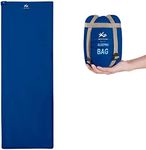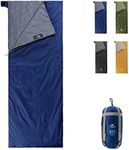Buying Guide for the Best Cheap Ultralight Sleeping Bag
Choosing a cheap ultralight sleeping bag is all about finding the right balance between weight, comfort, and practicality for your outdoor adventures. Ultralight sleeping bags are designed for people who want to carry as little weight as possible, making them ideal for backpackers, hikers, and travelers who need to save space and energy. When shopping for one, it's important to understand the key features that affect performance and comfort, so you can pick a bag that matches your needs and the conditions you'll face.WeightWeight refers to how heavy the sleeping bag is when packed. This is crucial for anyone who needs to carry their gear over long distances, as every ounce counts. Ultralight sleeping bags typically weigh between 1 to 2 pounds, with some even lighter. Lighter bags are easier to carry but may sacrifice warmth or durability. If you plan to hike long distances or want to minimize your pack weight, aim for the lower end of the weight range. However, if you prioritize comfort or expect colder conditions, a slightly heavier bag might be a better fit.
Temperature RatingThe temperature rating tells you the lowest temperature at which the sleeping bag will keep you warm. This is important because it helps you match the bag to the conditions you'll be sleeping in. Ratings are usually given in degrees Fahrenheit or Celsius. Bags rated for higher temperatures (like 40°F/5°C and above) are best for summer or warm climates, while those rated for lower temperatures (20°F/-6°C or lower) are better for cold weather. Choose a bag with a temperature rating that matches the coldest conditions you expect to encounter, but remember that ultralight bags often have less insulation, so you may need to wear extra layers if it gets chilly.
Insulation TypeInsulation is what keeps you warm inside the sleeping bag. The two main types are down and synthetic. Down insulation is lighter and packs smaller, making it popular for ultralight bags, but it can lose warmth if it gets wet. Synthetic insulation is usually bulkier and heavier, but it retains warmth even when damp and is often less expensive. If you expect dry conditions and want the lightest option, down may be best. If you might face wet weather or want a more affordable choice, synthetic is a good pick.
Packed SizePacked size refers to how small the sleeping bag becomes when compressed into its stuff sack. This matters because a smaller packed size leaves more room in your backpack for other essentials. Ultralight sleeping bags are designed to pack down very small, but the actual size can vary depending on insulation type and design. If you have a small backpack or need to save space, look for a bag that compresses tightly. If space is less of a concern, you can be more flexible with this feature.
Shape and FitThe shape and fit of a sleeping bag affect both comfort and warmth. Common shapes include mummy (narrower, more efficient at retaining heat) and rectangular (roomier, but less warm). Mummy bags are usually lighter and warmer for their weight, making them popular for ultralight use. However, if you move around a lot in your sleep or prefer more space, a semi-rectangular or rectangular bag might be more comfortable. Consider your sleeping style and whether you prioritize warmth or roominess when choosing the shape.
Shell MaterialThe shell material is the outer fabric of the sleeping bag, which affects durability and water resistance. Lightweight nylon or polyester fabrics are common in ultralight bags. Some have water-resistant coatings to help protect against moisture. If you expect damp conditions or want extra protection, look for a bag with a water-resistant shell. If you’ll be sleeping in dry environments or inside a tent, this may be less important.








